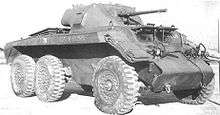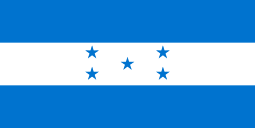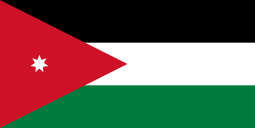T17 (armored car)
| T17E1 Armored Car | |
|---|---|
 | |
| Type | Armored car |
| Place of origin | United States |
| Service history | |
| In service | 1944–1980s |
| Used by | See Operators |
| Wars | World War II |
| Production history | |
| Designer | Chevrolet |
| Produced | October 1942 – April 1944 |
| No. built | 4,094 (3,844 Staghound, 250 Deerhound) |
| Specifications (Staghound Mark I) | |
| Weight | 14 t |
| Length | 17 ft 10 in (5.49 m) |
| Width | 8 ft 10 in (2.69 m) |
| Height | 7 ft 9 in (2.36 m) |
| Crew | 5 |
|
| |
| Armor | 9 to 44 mm |
Main armament | 1 × 37 mm M6 |
Secondary armament | 2–3 × .30 (7.62 mm) M1919 Browning machine guns |
| Engine |
2 × GMC 270 2 × 97 hp (72 kW) |
| Power/weight | 13.9 hp/tonne |
| Suspension | wheels, 4 x 4 |
Operational range | 450 miles (724 km) |
| Speed | 55 mph (89 km/h) |
The T17 and the T17E1 were two American armored car designs produced during the Second World War. Neither saw service with frontline US forces but the latter was supplied, via the United Kingdom, to British and Commonwealth forces during the war and received the service name Staghound. A number of countries used the Staghound after the war, with some of the vehicles continuing to serve into the 1980s.
History
In July 1941, the US Army Ordnance issued specifications for a medium armored car alongside a specification for heavy armored car (which resulted in the T18 Boarhound). Ford Motor Company built a six wheels, all driven (6 x 6) prototype which was designated T17 and Chevrolet a four wheels, all driven (4 x 4) model designated T17E1. At the same time, the British Purchasing Commission was also looking for medium and heavy armored cars for use in the war in North Africa. Had the U.S. adopted this, it would have been called the M6.
Both the T17 and T17E used the same turret which was designed by Rock Island Arsenal with British requirements driving some of the design features such as putting at least two crew in the turret and placing the radio in the turret so that it was close to the commander.[1]
T17

The T17 was armed with a 37 mm gun in a rotating turret, a coaxial machine gun and a bow machine gun. Power was from two Hercules JXD engines. In the interests of standardization, these replaced Ford's initial 90 hp engines.
The British gave the name Deerhound to the T17. Production started in October 1942. The US military eventually decided to adopt the lighter M8 Greyhound vehicle instead; as an interim measure T17 production continued until M8 production could be started. These were to be supplied as "International Aid" but US Army tests in early 1943 showed the T17 was lacking compared to the T17E and so Britain turned them down. The 250 units produced were disarmed and given to the United States Army Military Police Corps for use in the States.[2]
T17E1
The British allocated the name Staghound to the T17E series. British liaison officers had had contact with Macpherson, the Chevrolet engineer in charge of the project and felt they had influenced him sufficiently to produce something that met all their requirements. Accordingly, in December the British Purchasing Commission "formally requested" production of 300 vehicles; the US Army authorized production of 2,000 in January 1942. The British order was confirmed in March 1942 when the pilot T17E was delivered to the Aberdeen Proving Ground. Testing showed flaws but these were expected to be correctable and a further 1,500 were contracted for.[3] Production started in October 1942. The US Army convened a board to examine the state of the multitude of armored car projects and recommended in December 1942 the cancellation of the larger designs and standardization on a smaller vehicle. This lighter vehicle would appear as the M8 Greyhound vehicle. However the British applied for T17E1 production to be continued for the United Kingdom under Lend-Lease. 3,844 Staghounds were produced in total.
The Staghound was an innovative design that incorporated some advanced features. It had two rear-facing 6-cylinder engines with automatic transmissions (with 4 forward and 1 reverse gears) feeding through a transfer case to drive both axles. Either two- or four-wheel drive could be selected. Either engine could be shut down while in motion and taken out of the drive train. Additionally, a power steering pump was incorporated that could be switched on or off manually from the driver's instrument panel depending on steering conditions. Steering and suspension components were directly attached to the hull as the structure was rigid enough to dispense with the need for a separate chassis.
Operational service
The Staghound entered service too late for use in the North African Campaign where its combination of armor, range and main armament would have been an advantage in a light forces reconnaissance role. As a result, it first saw operational service in Italy, where many units found its large physical size too restrictive in the narrow roads, and streets of Europe. It saw most service at squadron and regimental headquarter level;[4] an armoured car regiment having three Staghounds with the Regimental HQ and three with each HQ of the four squadrons in the regiment.[5] Conditions for the Staghound improved when the Italian campaign became more mobile in the middle of 1944, and the Staghound was also used in north-west Europe campaign.[6]
After the war, the Staghounds were distributed among smaller NATO countries in Europe and to the Middle East.[6] The last new Staghound variant to be offered for export was probably a Swiss model retrofitted with several modern armament packages, including 30mm and 47mm anti-tank guns. It was marketed unsuccessfully to Syria.[7]
Operators
.jpg)
 Australia
Australia.svg.png) Belgium
Belgium Brazil
Brazil Canada
Canada Cuba – 20 ex-Israeli T-17E1s were purchased from Nicaragua due to US arms embargo on Cuba in 1956.
Cuba – 20 ex-Israeli T-17E1s were purchased from Nicaragua due to US arms embargo on Cuba in 1956. Denmark
Denmark Egypt
Egypt.svg.png) Greece – small number of vehicles left over post WW-II after British forces left the country.
Greece – small number of vehicles left over post WW-II after British forces left the country. Honduras
Honduras Hyderabad
Hyderabad India
India Israel
Israel Italy
Italy Jordan
Jordan Lebanon – Thirty in service with the Lebanese Army and Internal Security Forces (ISF) between 1949 and 1983. Some of these had the US M6 37 mm gun and 0.30-inch M1919 machine guns replaced by a British Ordnance QF 2 pounder and 7.92 mm BESA machine guns. Others had the turret replaced with that of a 75 mm gun-armed AEC Armoured Car. Passed on in 1976 to the Army of Free Lebanon, Lebanese Arab Army, Tigers Militia, Kataeb Regulatory Forces, Lebanese Forces, Al-Mourabitoun, People’s Liberation Army.
Lebanon – Thirty in service with the Lebanese Army and Internal Security Forces (ISF) between 1949 and 1983. Some of these had the US M6 37 mm gun and 0.30-inch M1919 machine guns replaced by a British Ordnance QF 2 pounder and 7.92 mm BESA machine guns. Others had the turret replaced with that of a 75 mm gun-armed AEC Armoured Car. Passed on in 1976 to the Army of Free Lebanon, Lebanese Arab Army, Tigers Militia, Kataeb Regulatory Forces, Lebanese Forces, Al-Mourabitoun, People’s Liberation Army. Netherlands
Netherlands New Zealand
New Zealand Nicaragua – 70 model T-17E1 were purchased from Israel after the Suez war. 20 were later resold to Cuba in 1957. 50 in service with the Nicaraguan National Guard from 1957 to 1979.
Nicaragua – 70 model T-17E1 were purchased from Israel after the Suez war. 20 were later resold to Cuba in 1957. 50 in service with the Nicaraguan National Guard from 1957 to 1979. Poland
Poland Southern Rhodesia – Twenty in service with the Rhodesian Army between 1949 and 1976.[8]
Southern Rhodesia – Twenty in service with the Rhodesian Army between 1949 and 1976.[8] Saudi Arabia
Saudi Arabia.svg.png) South Africa[9]
South Africa[9] Sudan
Sudan Switzerland
Switzerland United Kingdom – British Army and Royal Navy
United Kingdom – British Army and Royal Navy
Variants
- T17E1: 4x4 version built by Chevrolet for Britain. 2,844 units were produced.
- Staghound Mk I
- The T17E1 was armed with a 37 mm M6 gun, a coaxial .30 cal Browning 1919A4 machine gun and a 2-inch smoke mortar in a rotating turret. In the hull was mounted a .30 cal Browning 1919A4 machine gun.[10] Some T17E1 had an additional .30 Browning 1919A4 cal machine gun for anti-aircraft defense.
- The turret had power traverse and featured a turret basket (which limited the amount of internal crew storage). The 37 mm gun was gyroscopically stabilized.
- This variant had a crew of 5, commander, loader, gunner, driver, and hull machine gunner.
- This variant saw combat with the British, Free Polish, Canadian, New Zealand, Indian, and Belgian armies in Italy, Greece and Northwest Europe. After WWII, it saw further action in Cuba, Nicaragua, Lebanon and Rhodesia.[11]
- Staghound Mk II
- This was a field conversion that had a 3 inch howitzer Mk 1 for close support mounted in place of the 37 mm gun in the turret. The bow machine gun was removed. It is not known how many were converted. These were issued to the Armoured Car HQ section.
- Staghound Mk III
- Had a turret taken from an Ordnance QF 6 pounder gun armed Crusader tank and 7.92 mm Besa machine gun. Some of these were then re-fitted with the Ordnance QF 75 mm gun.[note 1][12] There was no bow machine gun. These had reached the front line by 1945, where it was supplied to heavy troops of armored car regiments. The total number ordered was around 100–300. After WWII, this version saw usage with Denmark and combat in Lebanon.
- Staghound Command
- The turret was removed and extra wireless equipment was installed.
- T17E2 (Staghound AA)
- The T17E2 was an T17E1 fitted with a Frazer-Nash-designed turret mounting two 0.5 inch M2 Browning heavy machine guns. The turrets were built in the US for British Motor Torpedo Boats. Redesign of the turret and mounting was carried out. 2,610 rounds were carried. The turret was open-topped and had an electric-hydraulic traverse system with a maximum slew rate of 55 degrees a second.[13] It had a reduced crew of 3: commander/gunner, loader and driver.[14]
- 1,000 units were produced between October 1943 and April 1944, when production stopped.
- T17E3
- T17E1 fitted with the turret of 75 mm Howitzer Motor Carriage M8, carrying the 75mm M2/M3 howitzer. This was trialled in December 1943, but never reached production.[14]
See also
Notes
- ↑ The 75 mm was a modification of the 6 pounder design and fitted the same mounting
- ↑ Zaloga p11
- ↑ Zaloga p15
- ↑ Zaloga p12
- ↑ Taylor, Dick: "The Stag's Story", Military Modelling, 5 October 2007, Page 34.
- ↑ B.T. White AFV Profile No 21, Armoured Cars Profile Publishing
- 1 2 Zaloga p5
- ↑ Bulletin VSAM D3 13
- ↑ Touchard, Guerre dans le bush! Les blindés de l’Armée rhodésienne au combat (1964–1979), p. 65.
- ↑ What arms embargo?
- ↑ Taylor, Dick: "The Stag's Story", Military Modelling, 5 October 2007, Page 29.
- ↑ Locke & Cooke, Fighting Vehicles and Weapons of Rhodesia (1995), p. 100.
- ↑ Classic AFVs No. 1 Crusader (1976) Patrick Stephens Ltd p21
- ↑ Taylor, Dick: "The Stag's Story", Military Modelling 5 October 2007, Page 28.
- 1 2 Taylor, Dick: "The Stag's Story", Military Modelling, 5 October 2007, Page 28.
References
- Doyle, David (2009). The Staghound: A Visual History of the T17E Series Armored Cars in Allied Service, 1940–1945. Delray Beach, FL: Ampersand Publishing. p. 128. ISBN 978-0-9773781-6-6.
- Lucy, Roger V. (2007). The Staghound in Canadian Service. Ottawa, ON: Service Publications. p. 24. ISBN 978-1-894581-37-0.
- War Department (1942). TM 9-741 Medium Armored Car T17E1. Retrieved 28 August 2010.
- War Department. TM 9-1741A.
- War Department (1943). TM 9-1741B.
- War Department (1943). TM 9-1741C Ordnance Maintenance Chassis, Hull and Turret for Medium Armored Car T17E1.
- War Department (1943). TM 9-2800 Standard Military Motor Vehicles.
- Zaloga, Steven J; Tony Bryan (2002). M8 Greyhound Light Armored Car 1941–91. Osprey Publishing. p. 48. ISBN 978-1-84176-468-9.
- Zaloga, Steven J (2009). Staghound Armored Car, 1942–62. Osprey Publishing. p. 48. ISBN 978-1-84603-392-6.
- Laurent Touchard, Guerre dans le bush! Les blindés de l’Armée rhodésienne au combat (1964–1979), Batailles & Blindés Magazine n.º 72, April–May 2016, pp. 64–75. ISSN 1765-0828 (in French)
- Ludovic Fortin, T17E1 Staghound Armored Car – Le char sur roues, Trucks & Tracks Magazine, December 2007 – January 2008 issue, pp. 48–67. (in French)
- Peter Gerard Locke & Peter David Farquharson Cooke, Fighting Vehicles and Weapons of Rhodesia 1965–80, P&P Publishing, Wellington 1995. ISBN 0-473-02413-6
External links
| Wikimedia Commons has media related to T17 Armored Car. |
- WWII Vehicles
- Staghound Mk III at armyvehicles.dk
- T17E1 Staghound Mark I at WarWheels.net
- Staghound Mark II at WarWheels.net
- Staghound Mark III at WarWheels.net
- T17E2 Staghound at WarWheels.net
- T17E3 Staghound at WarWheels.net
- AEC Staghound at WarWheels.net